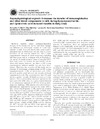Identificador persistente para citar o vincular este elemento:
https://accedacris.ulpgc.es/jspui/handle/10553/77937
| Título: | Supraphysiological oxytocin increases the transfer of immunoglobulins and other blood components to milk during lipopolysaccharide- and lipoteichoic acid–induced mastitis in dairy cows | Autores/as: | Wall, Samantha K. Wellnitz, Olga Hernández Castellano, Lorenzo Enrique Ahmadpour, Amir Bruckmaier, Rupert M. |
Clasificación UNESCO: | 3104 Producción Animal | Palabras clave: | Mastitis Blood-milk barrier Endotoxin Oxytocin |
Fecha de publicación: | 2016 | Publicación seriada: | Journal of Dairy Science | Resumen: | Bacterial mastitis causes pathogen-dependent changes of the blood-milk barrier, and these changes can influence the differential transfer of blood components to milk. It is well known that gram-negative pathogens such as Escherichia coli can cause a greater activation of the immune system and thus a more comprehensive transfer of blood components including IgG than gram-positive pathogens such as Staphylococcus aureus. Supraphysiological doses of oxytocin (OT) have been shown to increase the permeability of the blood-milk barrier; however, the effect of OT during experimentally induced mastitis has not been investigated. Therefore, the objective of this study was to examine if intravenous administration of OT during lipopolysaccharide (LPS)- or lipoteichoic acid (LTA)-induced mastitis could influence the transfer of blood components to milk. The hypothesis was that OT could induce a greater transfer of blood components during mastitis. Twenty-seven dairy cows were injected via the teat canal with LPS, LTA, or a saline control followed by an intravenous injection of OT 2 h following intramammary challenge. Milk samples were collected every half hour and analyzed for somatic cell count (SCC), IgG, lactate dehydrogenase (LDH), and serum albumin (SA). Due to the chosen dosage of LPS and LTA, there was no difference in SCC between quarters challenged with only LPS or LTA. Quarters challenged with LPS and OT had a higher SCC and a greater transfer of IgG, LDH, and SA compared with quarters challenged with only LPS. Quarters challenged with LTA and OT had a greater transfer of IgG, LDH, and SA, whereas the SCC increase did not differ from quarters only treated with LTA. In quarters treated only with OT, SCC, LDH, and SA increased, but no difference was observed in IgG concentration from untreated control quarters. In conclusion, there are pathogen-specific changes in the blood-milk barrier and OT can induce a greater transfer of blood components to milk in both LPS- and LTA-induced mastitis. Oxytocin could have implications for use as a mastitis therapy, as there was an increased transfer of IgG into the milk. | URI: | https://accedacris.ulpgc.es/handle/10553/77937 | ISSN: | 0022-0302 | DOI: | 10.3168/jds.2016-11548 | Fuente: | Journal of Dairy Science [ISSN 0022-0302], v. 99(11), p. 9165-9173 |
| Colección: | Artículos |
Citas de WEB OF SCIENCETM
Citations
36
actualizado el 18-ene-2026
Visitas
67
actualizado el 10-ene-2026
Descargas
63
actualizado el 10-ene-2026
Google ScholarTM
Verifica
Altmetric
Comparte
Exporta metadatos
Los elementos en ULPGC accedaCRIS están protegidos por derechos de autor con todos los derechos reservados, a menos que se indique lo contrario.
